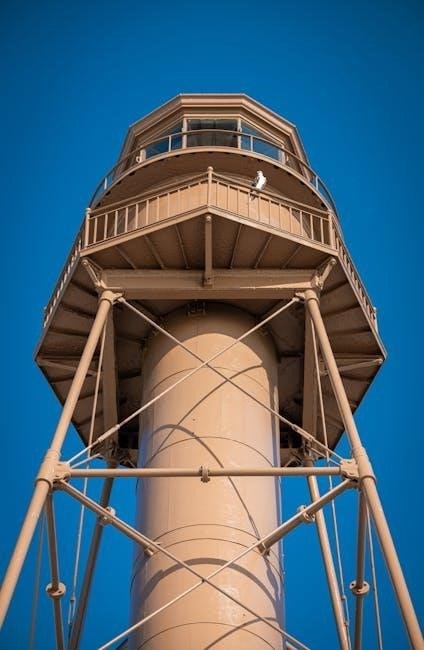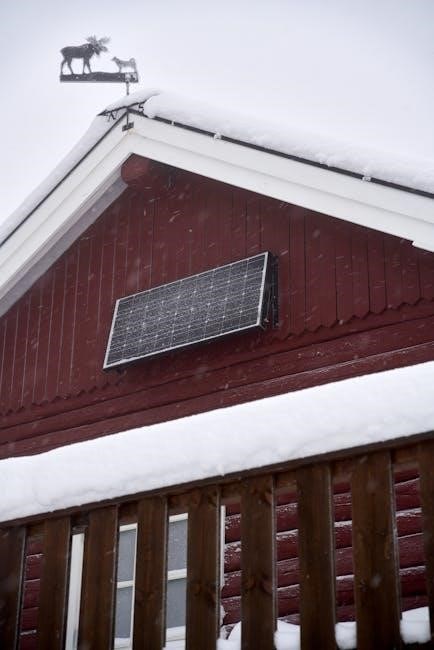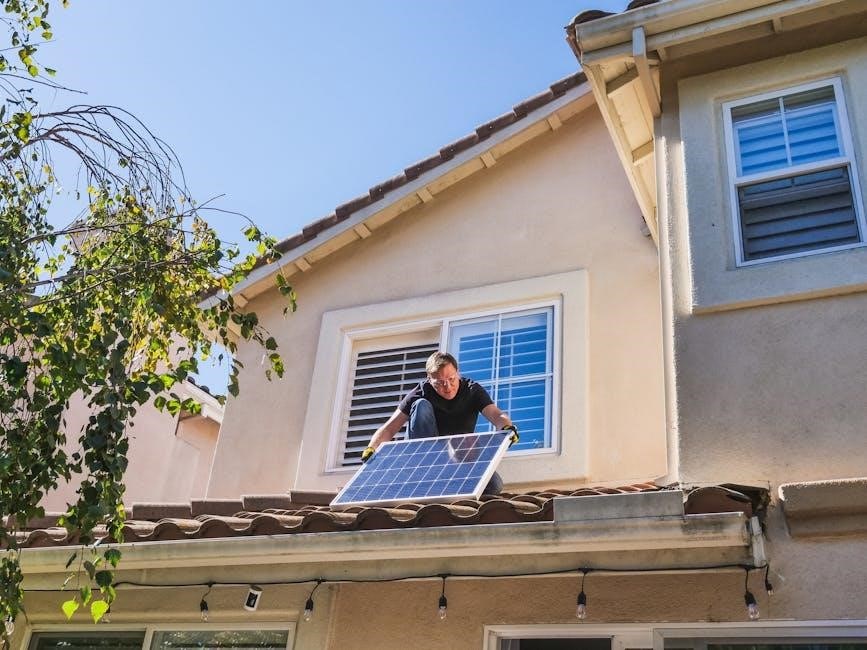Understanding Solar Angles
Solar angles determine the optimal orientation and tilt for solar panels to maximize energy production․ Understanding these angles is crucial for achieving maximum efficiency and savings․
Definition and Basics of Solar Angles
Solar angles refer to the geometric relationships between the Sun‚ the Earth‚ and a solar panel․ The primary angles include the solar zenith angle (angle from the vertical) and the solar azimuth angle (compass direction)․ These angles determine how sunlight strikes a surface at any given time and location․ Understanding these basics is essential for optimizing solar panel placement and energy absorption․ The apparent solar noon‚ when the Sun is highest in the sky‚ varies slightly from true solar noon due to time zones and daylight saving time․ Accurate measurement of these angles ensures maximum energy production‚ as panels should ideally face the Sun’s path․ Geographical location and time of year significantly influence solar angles‚ making them critical for system design and performance․

Importance of Solar Angles for Energy Efficiency
Solar angles play a critical role in maximizing energy efficiency for solar panel systems․ Proper alignment with the Sun’s path ensures optimal energy absorption‚ directly impacting overall performance․ Misalignment can lead to significant energy loss‚ reducing system efficiency by up to 30%․ Understanding solar angles helps in determining the ideal orientation and tilt for panels‚ which is essential for maximizing energy capture and savings․ Accurate angle calculations also enable better system design‚ ensuring panels perform optimally throughout the day and year․ This optimization not only enhances energy production but also reduces carbon emissions and lowers energy costs․ By aligning panels correctly‚ homeowners and businesses can achieve higher energy efficiency‚ making solar power a more sustainable and cost-effective solution․
The Solar Window: Understanding Daylight Availability
The solar window refers to the period during which sunlight is available for energy generation․ Daylight availability varies by location and season‚ impacting solar panel performance․ In regions with consistent daylight‚ such as near the equator‚ solar production remains relatively stable․ However‚ areas with seasonal variations face challenges‚ like shorter winter days․ Understanding daylight patterns helps optimize solar systems․ For instance‚ in locations with limited winter sunlight‚ panels may need a steeper tilt to capture more direct light․ Accurate assessments of daylight availability ensure efficient energy production‚ making solar panels a reliable choice even in regions with fluctuating sunlight․ This knowledge is key to maximizing energy output and ensuring consistent performance throughout the year․

Factors Influencing Solar Angles
Geographical location‚ seasonal variations‚ and solar panel orientation significantly impact solar angles․ These factors determine sunlight intensity and duration‚ affecting energy production and system efficiency․
Geographical Location and Its Impact
Geographical location plays a critical role in determining solar angles․ Regions closer to the equator receive more consistent sunlight‚ allowing for optimal solar panel orientation․ In contrast‚ areas farther from the equator experience varying sunlight patterns due to seasonal changes․ For instance‚ locations in northern latitudes require panels to be tilted at steeper angles during winter to capture limited sunlight․ Additionally‚ local terrain and altitude can influence solar irradiance‚ with higher elevations generally receiving more intense sunlight․ Understanding these geographical factors is essential for installing solar panels efficiently and maximizing energy production throughout the year․ Properly adjusting angles based on location ensures systems perform optimally in diverse environmental conditions․
Seasonal Variations in Solar Angles
Seasonal variations significantly impact solar angles‚ as the sun’s path across the sky changes throughout the year․ In winter‚ the sun is lower on the horizon‚ requiring steeper panel tilts‚ while summer demands shallower angles to maximize energy capture․ These variations are driven by the Earth’s axial tilt‚ affecting solar declination and the angle of incidence․ Understanding seasonal changes is crucial for optimizing solar panel performance‚ as failure to adjust angles can lead to reduced efficiency․ By accounting for these variations‚ homeowners and installers can ensure their systems capture the most sunlight year-round‚ improving overall energy production and savings․ Seasonal adjustments are a key component of maintaining peak solar panel efficiency․
Orientation of Solar Panels
The orientation of solar panels plays a critical role in determining their energy efficiency․ Ideally‚ panels should face south in the Northern Hemisphere to capture the most sunlight throughout the day․ However‚ east or west-facing orientations can still be effective‚ especially in regions with consistent morning or afternoon sun․ The optimal orientation depends on the geographical location and the site’s specific conditions‚ such as shading or roof slope․ Proper alignment ensures maximum exposure to solar radiation‚ directly impacting energy production․ For locations with varying sunlight patterns‚ adjustable mounting systems can be used to adapt panel orientation for better performance․ Understanding and optimizing panel orientation is essential for achieving peak energy efficiency and savings․ Proper installation and alignment are key to maximizing solar potential․

Calculating and Optimizing Solar Angles
Calculating solar angles involves using formulas to determine optimal tilt and orientation․ Software tools and seasonal adjustments help maximize energy production and efficiency‚ ensuring peak performance․
Formulas and Equations for Solar Angle Calculation
Solar angle calculations rely on specific formulas to determine the optimal tilt and orientation of solar panels․ The solar zenith angle‚ which measures the angle between the sun’s rays and the vertical‚ is calculated using the latitude‚ time of day‚ and season․ The equation for the solar zenith angle is:
cos(θ) = sin(δ) * sin(φ) + cos(δ) * cos(φ) * cos(ω)‚
where θ is the zenith angle‚ δ is the solar declination‚ φ is the latitude‚ and ω is the hour angle․ Additionally‚ the tilt angle for solar panels is often set close to the local latitude to maximize year-round energy production․ These formulas are essential for optimizing solar panel performance and ensuring maximum energy absorption throughout the day․ Accurate calculations are critical for achieving peak efficiency in solar energy systems․
Software Tools for Solar Angle Optimization
Various software tools are available to optimize solar angles for maximum energy efficiency․ PVWatts‚ a popular tool‚ calculates solar potential based on location‚ panel specifications‚ and shading․ SolarPath Designer allows users to simulate and adjust panel tilt and azimuth for optimal performance․ These tools use complex algorithms to analyze geographical data‚ ensuring precise calculations․ By inputting local coordinates and panel details‚ users can determine the ideal solar angles for their system․ Additionally‚ software like HelioScope and SolarAnywhere provide detailed shading analysis and performance predictions․ These tools are essential for installers and engineers to maximize energy output and reduce costs․ Regular updates and advanced features make them indispensable for modern solar installations․
Adjusting Solar Angles for Seasonal Changes
Seasonal variations in solar angles require periodic adjustments to optimize energy production․ During winter‚ when the sun is lower‚ panels should be tilted steeper to capture more sunlight․ In summer‚ a shallower tilt maximizes exposure․ Many modern systems use tracking technology to automatically adjust angles‚ while others rely on manual adjustments․ Understanding local seasonal solar patterns helps determine the best tilt and orientation․ For example‚ in regions with distinct seasonal changes‚ adjusting panels every few months can significantly enhance efficiency․ Regular monitoring ensures optimal performance‚ making seasonal adjustments a critical part of maintaining a solar system’s effectiveness throughout the year․

Solar Panel Installation Considerations
Solar panel installation requires careful planning‚ including mounting systems‚ roof slope analysis‚ and addressing shading issues to ensure optimal energy production and compliance with local regulations․
Mounting Systems and Their Effects
MOUNTING SYSTEMS play a critical role in solar panel efficiency․ Fixed mounts are cost-effective and simple‚ while adjustable mounts allow seasonal tilt modifications for optimal energy capture․ Tracking mounts follow the sun’s movement‚ maximizing energy production․ Each system’s durability and material impact longevity and performance․ Proper installation ensures panels remain secure‚ withstand weather conditions‚ and maintain optimal angles․ The choice of mounting system depends on geographical location‚ roof type‚ and local building codes․ Correct installation maximizes energy output and ensures system longevity․ Understanding these factors helps in selecting the most suitable mounting solution for specific conditions‚ ensuring efficient energy generation and adherence to safety standards․
Impact of Roof Slope and Orientation
ROOF SLOPE and orientation significantly influence solar panel performance․ The ideal slope matches the latitude of the location for maximum sunlight capture․ South-facing roofs receive consistent sunlight in the Northern Hemisphere‚ optimizing energy production․ East-West orientations can still be effective but may yield slightly less energy․ Steeper slopes are beneficial in areas with heavy snowfall to prevent accumulation․ Conversely‚ flatter roofs in warmer climates can reduce summer overheating․ Understanding local conditions helps determine the best configuration․ Proper alignment enhances energy efficiency and ensures panels operate at peak performance throughout the year‚ making it essential to assess these factors during installation planning․
Addressing Shading Issues
Shading significantly impacts solar panel efficiency‚ as even partial shade can reduce energy production․ Trees‚ nearby buildings‚ and roof obstructions are common causes․ Regular tree trimming and strategic panel placement help mitigate these issues․ Installing panels at a higher angle or using tracking systems can minimize shade effects․ Additionally‚ conducting a site analysis ensures optimal placement․ Advanced tools like solar path finders identify potential shading areas․ Addressing shading early in the installation process maximizes energy output and ensures long-term performance․ Proper planning and maintenance are essential to maintain efficiency and prevent energy loss due to shading․ This step is critical for achieving the best results from your solar panel system․

Regional Variations in Solar Angles
Regional solar angles vary significantly by latitude and climate․ Northern and Southern Hemispheres differ in sunlight patterns‚ affecting panel orientation․ Urban vs․ rural settings also influence solar angles․
Northern vs․ Southern Hemisphere Differences
The Northern and Southern Hemispheres experience opposite solar angle patterns due to Earth’s axial tilt․ In the Northern Hemisphere‚ the sun’s highest point is in the south‚ while in the Southern Hemisphere‚ it is in the north․ Seasonal variations are reversed‚ with northern regions having lower solar angles in winter and southern regions experiencing the opposite․ This affects solar panel orientation and tilt requirements․ For maximum efficiency‚ panels in the Northern Hemisphere are often angled steeper in winter and shallower in summer‚ while the Southern Hemisphere follows the reverse pattern․ Understanding these differences is essential for optimizing solar energy production across regions․ Local latitude and climate also influence the ideal solar angles for each hemisphere․
Urban vs․ Rural Solar Angle Considerations

Urban and rural settings present distinct challenges for solar angle optimization․ In urban areas‚ taller buildings and dense infrastructure create shading issues‚ reducing sunlight availability․ This necessitates precise solar panel placement and angle adjustments to minimize obstruction․ Rural areas‚ with fewer obstructions‚ generally allow for more straightforward solar installations․ However‚ rural locations may require adjustments for seasonal variations in solar angles due to less consistent sunlight patterns․ Additionally‚ urban areas often have stricter regulations and space constraints‚ influencing panel orientation and tilt․ Understanding these differences is crucial for maximizing solar efficiency in both environments․ Proper planning and installation can mitigate urban shading challenges while leveraging rural areas’ open spaces for optimal solar performance․ Both settings benefit from tailored solar angle strategies to enhance energy production and savings․

Maintenance and Adjustment
Regular maintenance ensures solar panels operate efficiently‚ while seasonal adjustments optimize energy production by aligning panels with varying solar angles throughout the year․

Seasonal Adjustment of Solar Panels
Seasonal adjustments are crucial for maximizing solar panel efficiency․ During summer‚ when the sun is higher‚ a shallower tilt angle is optimal․ In winter‚ a steeper angle captures more sunlight․ Adjustments ensure panels align with the sun’s seasonal altitude‚ enhancing energy production․ Regular checks and cleaning are essential to maintain performance․ Manual or automatic tracking systems can simplify this process․ Proper seasonal tuning not only boosts energy output but also reduces long-term costs‚ ensuring panels operate at their best year-round․ This practice is vital for achieving consistent energy efficiency and savings‚ especially in regions with pronounced seasonal variations․ Regular maintenance and precise adjustments ensure optimal performance throughout the year․
Monitoring and Performance Tracking
Monitoring and performance tracking are essential for ensuring solar panels operate at peak efficiency․ Advanced software tools provide real-time data on energy production‚ allowing users to identify and address issues like shading or misalignment․ Regular performance checks help maintain optimal solar angles and alignment‚ ensuring maximum energy output․ Automated systems can track performance metrics and alert users to potential issues․ By analyzing energy production trends‚ users can make informed adjustments to panel angles or orientation․ This proactive approach minimizes downtime and maximizes energy savings․ Consistent monitoring ensures solar panels perform efficiently‚ delivering reliable energy production and long-term savings․ It is a critical step in maintaining and optimizing solar panel systems for consistent performance․

Tools and Resources
Utilize solar angle calculators‚ software tools like SolarPathfinder‚ and apps such as SunSurveyor to determine optimal angles and track performance․ These resources simplify solar angle optimization for maximum efficiency․
Online Calculators for Solar Angles
Online solar angle calculators are essential tools for determining the optimal tilt and orientation of solar panels․ These calculators use geographical location‚ time of day‚ and season to provide precise angle recommendations․ By inputting your latitude and longitude‚ they calculate the solar zenith and azimuth angles‚ ensuring maximum energy production․ Many calculators also account for roof slope and shading factors․ Tools like SolarPathfinder and SunSurveyor offer detailed 3D visualizations to assess sunlight patterns․ They simplify the process of optimizing solar panel placement‚ making it accessible for both professionals and homeowners․ Regular use of these calculators ensures your system operates at peak efficiency year-round‚ adapting to seasonal changes and environmental conditions․
Mobile Apps for Solar Optimization
Mobile apps are revolutionizing solar optimization by providing real-time data and tools for maximizing energy production․ Apps like Sun Surveyor and SolarPathfinder offer precise solar angle calculations‚ 3D visualizations‚ and shading analysis․ They enable users to assess sunlight patterns throughout the day and year․ SunTracker provides real-time sun tracking‚ while PVWatts estimates system performance based on location and angle inputs․ These apps also integrate weather data and allow users to adjust panel angles for seasonal changes․ By leveraging these tools‚ homeowners and installers can ensure optimal energy output‚ reduce costs‚ and monitor performance on the go․ They are essential for maintaining efficiency and addressing environmental factors dynamically․
Best Practices for Solar Angle Optimization
Optimizing solar angles requires a combination of careful planning and ongoing adjustments․ Start by assessing your location’s geographical and seasonal variations to determine the ideal tilt and orientation; Use solar mapping tools to analyze sunlight patterns and ensure minimal shading․ Regularly adjust panel angles to account for seasonal changes‚ typically every 2-3 months‚ to maintain maximum efficiency․ Invest in monitoring systems to track performance and identify potential issues․ Consider using dual-axis tracking systems for dynamic adjustments․ Finally‚ consult local solar guidelines and seek professional installation to ensure compliance and optimal results․ By following these practices‚ you can significantly enhance energy production and long-term system performance․
Future Trends in Solar Angle Technology
Future trends in solar angle technology emphasize advanced tracking systems and smart adjustments․ Dual-axis tracking systems are becoming more prevalent‚ allowing panels to dynamically adjust throughout the day․ AI-driven optimization tools will predict ideal angles based on weather and seasonal data‚ enhancing efficiency․ Integration with IoT devices enables real-time monitoring and automatic tilt adjustments․ Bifacial panels and transparent solar materials are gaining traction‚ offering innovative ways to capture sunlight․ Energy storage solutions are also evolving to complement optimized solar angles․ These advancements promise higher energy output‚ reduced costs‚ and greater sustainability‚ making solar power more accessible and efficient for future generations․
